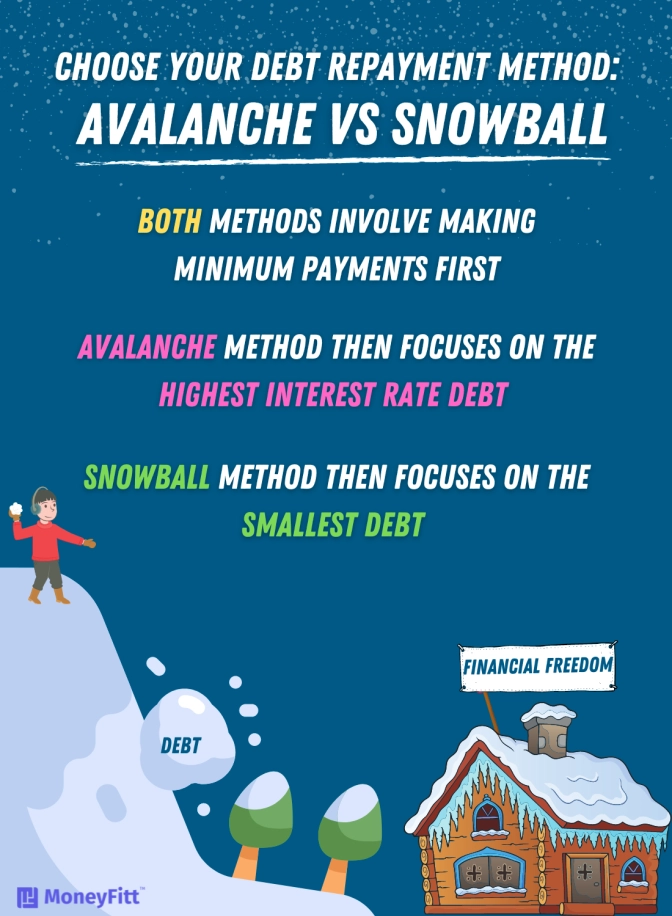Too Much Debt: How to Start Reducing the Debt
Keeping track of your loans and sticking to a budget are key!
- If you find yourself building up debt that you are increasingly unable to pay off, this may be a sign of overspending, and you need to be more careful!
- If you have multiple loans, a debt avalanche means that you make the minimum payments on all of your debts and then you use extra funds to pay off the debt with the highest interest rate.
- With a debt snowball, you’ll still make minimum payments on all your debts, but the idea is to first pay off your smallest debts before moving on to the bigger ones.
Debt Reduction: Paying off Debts
You will want to ask your bank to help you develop a plan to reduce and pay off your debt, either starting with the debts that have the highest interest rates first (the “avalanche” approach) or the smallest debts (the “snowball” approach). The debt with the highest interest rates may not be the largest in size, but due to the compounding effect of interest, you are likely to end up paying more in interest payments than the principal amount.
You may have multiple debts of varying sizes and interest rates, and it may be challenging to keep track of everything at once. To start, you will want to check with your bank about the exact loan amounts, interest rates and loan tenures. Once you have the nitty-gritty details sorted out, it will be easier for you to develop a repayment strategy.
As we’ve talked about above, you would also want to keep an eye on your budget. You may want to follow the 50:30:20 rule, dividing your after-tax income into three categories: essential needs (50%), discretionary spending (30%) and savings and investments (20%).
Note that high-interest debt repayment should be coming from the 20% category, while other debt repayments should be in the 50% category. This is because minimum repayments should be considered essential while paying off high-interest debt would save you extra principal and interest further down the road, which goes into the savings portion of your budget.

The Debt Avalanche Method
With the debt avalanche method, you pay off the debt with the highest interest rate first: this means that you’ll end up paying less interest in the long run. To see how this might happen, let’s look at an example:
Jack has three different debts to pay off:
- Credit card loan: $10,000 with a 20% APR.
- Student loan: $12,000 with a 30% APR.
- Car loan: $8,000 with a 10% APR.
Jack devotes $3,000 every month to pay off his debts:
- He makes payments of $500 each on the credit card and car loan because that is their minimum payment amount.
- He is prioritising paying off the student loan as it has the highest interest rate, meaning he makes a larger payment of the remaining $2,000 on that.
- He will be able to pay off all his debts in 11 months.
- He’ll also be paying a total of $2,734 in interest.
The Debt Snowball Method
To illustrate how the debt snowball method works differently from the debt avalanche, let’s take a look at Jack’s debts again.
- Credit card loan: $10,000 with a 20% APR.
- Student loan: $12,000 with a 30% APR.
- Car loan: $8,000 with a 10% APR.
Repayment:
- Since the car loan is the smallest, Jack will make larger repayments to pay this off faster, then move on to the other two.
- He can make a monthly payment of $2,000 on the car loan and $500 each for the credit card and student loans.
- He will end up paying $3,964 in interest ($1,230 more than with the debt avalanche method!)
- It will take one month longer to pay everything off.
Which Is Better for You?
By simply looking at the amount of interest paid and the amount of time needed to get rid of all the debt, you might be thinking the debt avalanche seems much better than the debt snowball. However, the debt avalanche takes much more discipline and motivation to implement, so it may not be for everyone. Since the smallest debts are settled faster with the debt snowball, creating a good sense of progress and more encouragement and momentum, many experts point to psychology and prefer that method.

Of course, it needn’t be entirely an “either/or” question, and you could select a smaller high rate debt rather than the one with the absolute smallest debt or highest rate. Or the small debt with the highest rate! But whichever you choose: stick to it and don’t add any more debt to the pile!
Many avoidable and unavoidable things could have led to you having lots of debt, so don't be too hard on yourself; just start to take action today!
Conclusion
If you’re still unsure which method is better for you, you can check out a snowball vs avalanche calculator here, but ultimately, the best plan is the one you will stick to! Paying off debts needn’t be a headache, so after choosing a repayment method, remember the essentials: be punctual with your payments, have an emergency fund ready, and stick to your budget faithfully, and soon your debt burden will be as light as a snowflake!
TOO MUCH DEBT: DEBT REDUCTION. COMPLETED. ✅
Sources:
- https://www.moneysense.gov.sg/articles/2018/11/credit-reports-and-creditworthiness
- https://www.investopedia.com/ask/answers/12/reasonable-amount-of-debt.asp
- https://www.investopedia.com/credit-cards/balance-transfer-credit-card/
- Header photo from Pexels
- https://www.investopedia.com/articles/personal-finance/080716/debt-avalanche-vs-debt-snowball-which-best-you.asp
- https://www.wellsfargo.com/goals-credit/smarter-credit/manage-your-debt/snowball-vs-avalanche-paydown/
- https://www.cnbc.com/select/debt-snowball-vs-debt-avalanche/
